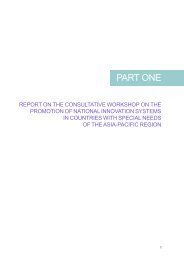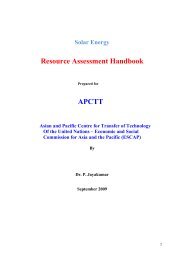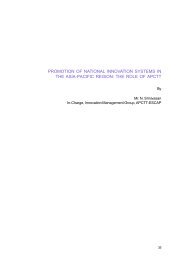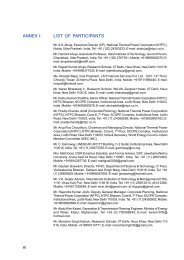coal-fired plants aged more than 25 years and having capacity below 300 MW withlarger and significantly more efficient plants and, where technically and economicallyappropriate, replacing or re-powering larger inefficient plants with high-efficiency (morethan 40 per cent) plants. Technologies that help improve the efficiency of coal-firedpower plants are discussed below.(a) Fluidized Bed Combustion (FBC)Fluidized bed combustion (FBC) is a very flexible method of electricity production –most combustible material including coal, biomass and general waste can be burnt.FBC systems improve the environmental impact of coal-based electricity, reducingSOx and NOx emissions by 90 per cent. In fluidized bed combustion, coal is burned ina reactor that consists of a bed through which gas is fed to keep the fuel in a turbulentstate. This improves combustion, heat transfer and recovery of waste products. Thehigher heat exchanger efficiencies and better mixing of FBC systems allows them tooperate at lower temperatures than conventional pulverized coal combustion (PCC)systems. By elevating pressures within a bed, a high-pressure gas stream can beused to drive a gas turbine, generating electricity.FBC systems fit into two groups, non-pressurized and pressurized systems, and twosub-groups, circulating or bubbling fluidized bed. Non-pressurized FBC systems operateat atmospheric pressure and are the most widely applied type of FBC. They have 30-40 per cent efficiencies, similar to PCC. Pressurized FBC systems operate at elevatedpressures and produce a high-pressure gas stream that can drive a gas turbine, creatinga combined cycle system that is more than 40 per cent efficient. Bubbling FCB usesa low fluidizing velocity so that the particles are held mainly in a bed, and is generallyused with small plants offering a non-pressurized efficiency of around 30 per cent.Circulating FCB uses a higher fluidizing velocity so that the particles are constantlyheld in the flue gases, and are used for much larger plants offering efficiencies above40 per cent. The flexibility of FBC systems allows them to utilize abandoned coalwaste that previously could not be used due to its poor quality.(b) Supercritical and ultra-supercritical technologiesCurrently used sub-critical steam cycles operate well below the steam pressure of 221bar. New PCC systems that utilize supercritical and ultra-supercritical technologiesoperate at increasingly higher temperatures (600 ° C) and pressures (300 bar), andtherefore achieve higher efficiencies (45 per cent) than conventional PCC units andsignificant CO 2reductions. Supercritical steam cycle technology has been used fordecades and is becoming the system of choice for new commercial coal-fired plants inmany countries.At present R&D is under way for ultra-supercritical units that operate at even higherefficiencies, potentially up to around 50 per cent. The introduction of ultra-supercriticaltechnology has been driven over recent years in countries such as Denmark, Germanyand Japan, by the need to achieve improved plant efficiencies and reduce fuel costs.Research is focusing on the development of new steels for boiler tubes and on highalloy steels that minimize corrosion. These developments are expected to result in adramatic increase in the installation of ultra-supercritical units in the coming years.50
Advantages of supercritical plants over sub-critical plants are reduced fuel costs, 15per cent reduction on CO 2emissions and good part load efficiency. However, they are3-10 per cent costlier than sub-critical plants. Market penetration of supercriticalsystems is expected to rise from current level of 10 per cent to 50 per cent of newplants by 2020, according to Reliance Review of Energy Markets, 2002.(c) Integrated gasification combined cycle (IGCC)IGCC, a technology with several benefits, does not burn coal directly to produce steam.It uses a gasifier to convert coal (or other carbon-based materials) into synthesis gas(syngas) – a mixture of hydrogen and carbon monoxide (CO) – and uses this gas torun a gas turbine. Coal is combined with oxygen and steam in the gasifier to producesyngas, which is then cleaned to remove impurities, such as sulphur, and used in agas turbine to produce electricity. Waste heat from the gas turbine is recovered tocreate steam, which drives a secondary steam turbine to produce more electricity –hence the combined cycle system. This combination brings increased efficiency, uses30 per cent less water and reduces CO 2, NOx and SOx. By adding a ‘shift’ reaction,additional hydrogen can be produced and the CO converted to CO 2, which can then becaptured and stored. IGCC efficiencies typically reach the mid-40s, although plantdesigns offering around 50 per cent efficiencies are achievable.Reliability and availability have been challenges facing IGCC development andcommercialization. Cost has also been an issue for the wider uptake of the technology:IGCC is expensive at US$1,500/kW compared with US$750/kW for sub-critical plantand US$1,000/kW for supercritical plant. Nevertheless, recent studies in the UnitedStates by IGCC Alliance claim that the technology is competitive with reducedemissions.(d) Inter-fuel substitution – coal to liquidCoal to liquid (CTL) technology can counter petroleum-related security risks, as it canprovide ultra-clean fuels for transportation, power generation and domestic use. SouthAfrica has CTL production since 1950. The United States, China, Australia, India,Indonesia and Germany are in the race at different levels. The current status of CTL inIndia needs to be discussed to evolve suitable policy support and roadmap.(e) Clean coal technologies (CCT)An array of CCT is being developed at the global level to address environmental issues.Pollution control technologies are installed to reduce SOx, NOx and particulateemissions. Retrofit programmes for old plants can improve their performance. WECrecommends that greater deployment of such technologies be encouraged. New powerplants are being built to perform at supercritical conditions of temperature and pressure,increasing plant efficiencies to 40-50 per cent. China added 93,000 MW of coal-firedplants in 2006 with a first 1,000 MW supercritical plant. India too must phase out old,small, obsolete and inefficient plants and replace them with ones that use CCT.(f) Carbon capture and storage (CCS)CO 2is removed from flue gases and injected underground into deep saline aquifers orused for enhanced oil recovery. Pipelines are preferred for transporting CO 2for distances51
- Page 1 and 2:
ADVANCES IN FOSSIL FUELTECHNOLOGIES
- Page 3 and 4:
ADVANCES IN FOSSIL FUELTECHNOLOGIES
- Page 5 and 6:
CONTENTSABBREVIATIONSiiiPART ONEREP
- Page 7 and 8:
ABBREVIATIONSAC : Alternating curre
- Page 9: OECD : Organization for Economic Co
- Page 12 and 13: IORGANIZATION OF THE WORKSHOPA. Bac
- Page 14 and 15: D. Election of officersThe followin
- Page 16 and 17: IIICONSIDERATION OF ISSUESA. Backgr
- Page 18 and 19: emissions. Underground coal gasific
- Page 20 and 21: 800 MWe, a steam pressure of 300 kg
- Page 22 and 23: • Materials development & manufac
- Page 24 and 25: Figure 1-5: Strategy for commercial
- Page 26 and 27: tonnes, the state-owned enterprise
- Page 28 and 29: • Ensuring not just easy FDI entr
- Page 30 and 31: MW ultra-supercritical units; and s
- Page 32 and 33: the captive generation capacity) on
- Page 34 and 35: and other financial institutions -
- Page 36 and 37: and higher efficiency power generat
- Page 38 and 39: energy technologies, which can enab
- Page 40 and 41: • Such massive financial inputs c
- Page 43 and 44: BASELINE REPORT ON FOSSIL FUEL TECH
- Page 45 and 46: B. General R&D climate in the count
- Page 47 and 48: a convenient way to envisage energy
- Page 49 and 50: to mature and become more cost-comp
- Page 51 and 52: emissions, at least relative to sin
- Page 53 and 54: The Ministry of Power (MoP), which
- Page 55 and 56: 3. Bio-energyBio-energy, widely ava
- Page 57 and 58: in such a canal will rotate at a lo
- Page 59: in tackling climate change. A one p
- Page 63 and 64: existing power plants but also to b
- Page 65 and 66: BASELINE REPORT ON FOREIGN DIRECT I
- Page 67 and 68: CEA at 598 mt. This is mainly due t
- Page 69 and 70: For India to maintain its momentum
- Page 71 and 72: Table 2-5: Electricity generation t
- Page 73 and 74: Growth, which submitted its interim
- Page 75 and 76: 3. Future challengesThe future chal
- Page 77 and 78: development worked out. Public-priv
- Page 79 and 80: Linking FDI to technology transferI
- Page 81 and 82: The total requirement of fund durin
- Page 83 and 84: Funding from multilateral agenciesM
- Page 85 and 86: cooperation will be essential in so
- Page 87: Planning Commission, Government of
- Page 90 and 91: ANNEX I:LIST OF PARTICIPANTSMr. A.K
- Page 92 and 93: Mr. S.C. Shrivastava, Joint Chief (
- Page 94 and 95: ANNEX II:PROGRAMME6 June 2012, Wedn
- Page 96 and 97: ANNEX III:AN OVERVIEW OF ADVANCED F
- Page 98 and 99: • Technology solutions are also v
- Page 100 and 101: Table 3-5: Improvement in cycle eff
- Page 102 and 103: • No liquid effluent formation;
- Page 104 and 105: Figure 3-5: Advancement of gas turb
- Page 106 and 107: Figure 3-8: Goal 2 - New clean tech
- Page 108 and 109: Compared with conventional power pl
- Page 110 and 111:
Figure 3-14: Thermax coal gasificat
- Page 112 and 113:
ANNEX VII:GE ENERGY AND ADVANCED FO
- Page 114 and 115:
ANNEX VIII:SWOT ANALYSIS OF FOSSIL
- Page 116 and 117:
By 2035, cumulative CO 2emissions f
- Page 118 and 119:
• Falling prices of renewable ene
- Page 120 and 121:
Figure 3-20: New advanced coal powe
- Page 122 and 123:
ANNEX X:ENERGY CONSERVATION: ERDA
- Page 124 and 125:
Table 3-11: Energy cost and intensi
- Page 126 and 127:
300Figure 3-23: Trends in coal use
- Page 128 and 129:
C. Gaps in coal use efficiencyFigur
- Page 130 and 131:
ANNEX XII:FINANCING OF THE POWER SE
- Page 132 and 133:
With the entry of many private sect
- Page 134 and 135:
for future requirements should be t
- Page 136 and 137:
Short supply of coal has started af
- Page 138:
Figure 3-35: Life-cycle of technolo







